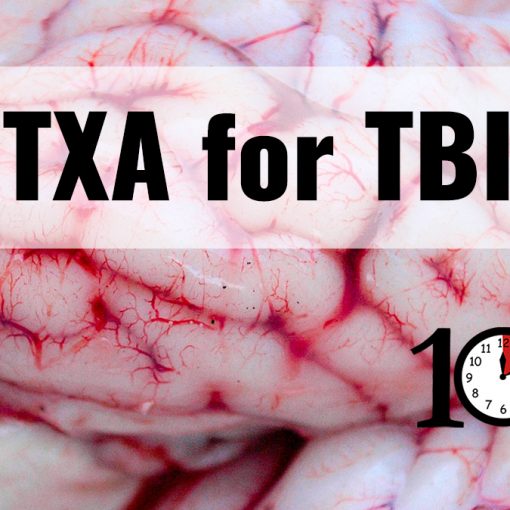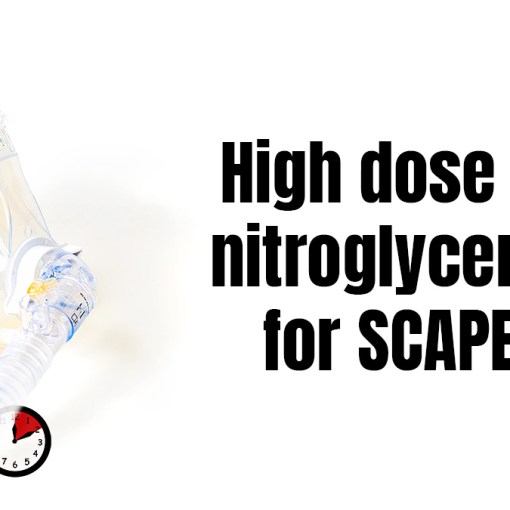Case
A 31 year old female is brought into the emergency department by ambulance after she collapsed at a family birthday party. She has a diffuse red rash, a blood pressure of 70/35, and an oxygen saturation of 88% on room air. She is wearing a medicalert bracelet. Her uncle guiltily admitted to EMS that he hadn’t told people that the vegan “cheese ball” he brought was actually just pureed nuts. It’s time to review that management of severe anaphylaxis.
My approach
My original plan was to make this a one word post: Epinephrine! However, there is probably a little more detail worth considering.
The first step, before monitors are attached or IVs are even attempted, is to administer epinephrine 0.5mg IM. (Never use the subcutaneous route – in shock states blood flow to the skin, and therefore drug absorption, is too unreliable.) IM epinephrine can be repeated every 3-4 minutes.
Next, one nurse is put in charge of starting 2 IVs and a 2L bolus of the crystalloid of your choice, preferably using a pressure bag. Another nurse is putting the patient on the monitors. Start the patient on 100% oxygen using a nonrebreather at flush rate, with the addition of nasal prongs in anticipation of a possible intubation.
Although rarely possible in the ED, attempt to identify the antigen and remove it. (Stop the blood transfusion, discontinue the antibiotic, remove the latex, pull out the stinger, etc.)
Quickly assess the airway. Listen for air movement, stridor, and voice changes. Look for signs of edema and accessory muscle use. The airway is the biggest potential problem in severe anaphylaxis and also represents the most complex decision to make. Although this post cannot not address all possible scenarios, for simplicity I like to consider two distinct airway presentations in anaphylaxis: rapidly developing obstruction and more gradual angioedema.
Rapidly developing upper airway obstruction
- If a patient is rapidly deteriorating in front of you despite epinephrine, you have to act immediately. The longer you wait, the more difficult it will be to secure the airway
- This is not the time for fancy new intubation techniques that you are not intimately familiar with.
- Be prepared for a surgical cricothyroidotomy. I would have the neck marked and anesthetized. Ideally, I would have another physician in the room ready to cut if I cannot intubate from above (the double setup).
- Inform the room this is an anticipated difficult airway. Ensure that all the difficult airway equipment is out. I would actually open multiple smaller sized endotracheal tubes and have them prepared with a stylet. Place a bougie across the patient’s chest where it is easily reachable.
- I believe in performing a classic RSI in this situation. Some people will argue for a sedative only intubation, with the very reasonable logic that paralysis could result in a loss of airway tone, turning a partially obstructed airway into a complete obstruction. However, in the rapidly deteriorating patient I want my first attempt to be my best attempt and I think RSI gives me the best possible intubating conditions. Of course, I am already mentally and physically prepared to cut the neck if necessary.
Gradually developing angioedema
- This is the patient that you can seriously harm with paralysis, if you take a quasi-stable airway and create a complete obstruction.
- My plan would involve an awake intubation, ideally done with an intubating bronchoscope. For more information on awake intubation, see the links at the bottom of the post.
- I would landmark the neck and have my cricothyroidotomy kit at the bedside.
- There may be time to call for help from anesthesia and ENT. It may make sense to approach this airway with a double set-up in the OR.
Persistent Shock
If hypotension or signs of shock persist beyond the second dose of IM epinephrine, or if the patient is critically ill at any point, I switch to intravenous epinephrine in addition to continuing aggressive fluid resuscitation. A controlled drip is always the best, but never immediately available. To temporize in adult patients I use push-dose epinephrine:
- Take a 10ml syringe of normal saline and discard 1ml (leaving 9ml of saline in the syringe)
- Withdraw 1ml of the crash cart epinephrine into this syringe. (Out of 1mg of epinephrine, you will be withdrawing 1/10th or 100mcg. Diluted in 10ml of normal saline, this leaves you with a solution of 10mcg/ml)
- Label the syringe to prevent medication errors
- Inject 0.5-2ml (5-20mcg) every 1-2 minutes, titrating to blood pressure and/or symptoms
If there is bronchospasm or any signs of respiratory compromise
- Treat exactly like you would severe asthma.
- Continuous salbutamol by nebulizer should be the primary therapy (in addition to the IM/IV epinephrine).
- In any case of anaphylaxis that did not respond quickly to salbutamol, I would also use nebulized epinephrine.
- The addition of ipratropium bromide is reasonable if it doesn’t interfere with delivering the beta-agonist.
- There is limited evidence for magnesium in asthma, and considering the potential side effect of hypotension I would be hesitant to use it in anaphylaxis.
If the patient is on a beta-blocker
- The key addition in the setting of a beta-blocker is glucagon
- 1 mg IV every 5 minutes
- Can increase the dose up to 3-5 mg
- Titrate to resolution of hypotension
- Be prepared for vomiting
Special Case: Pediatrics
There aren’t any major changes to the algorithm for children except the dosing of epinephrine. For IM epinephrine:
- The dose is 0.01mg/kg
- An Epi-pen jr. is 0.15mg
If IV epinephrine is required:
- The dose is 0.1-0.5mcg/kg/min
Although I always prefer a controlled drip in pediatrics, these can take eons to set up in a resuscitation. To get an IV epinephrine drip going quickly, my preferred method is:
- Take 1mg of epinephrine from the crash cart. Inject the full 1mg into 1L of normal saline and mix well. This leaves you with a concentration of 1mcg/mL of epineprhine
- Label this bag VERY clearly, so it cannot be confused with fluid boluses that are also likely being given
- In general, start the drip at around 1 ml/min (ie, 1mcg/min)
- The starting dose of IV epinephrine in children is 0.1mcg/kg/min. Therefore, in a 10kg child, 1mcg/min would be appropriate
- Titrate to blood pressure
Severe anaphylaxis notes
You may notice that I did not mention antihistamines (whether H1 or H2) or steroids anywhere in the above post. The evidence that these do anything for anaphylaxis is poor, but at best they are to prevent biphasic reactions and help with mild symptoms like skin itch. There is enough to get done during a resuscitation, so I think they should be ignored.
Other FOAMed Resources
Paucis Verbis: Anaphylaxis on ALiEM
Two new anaphylaxis guidelines on RESUS.ME
Episode 12 – Back to biphasics on FOAMcast
Pearls and Pitfalls in Anaphylaxis on Life in the Fastlane
Anaphylaxis – Critical Care Compendium on Life in the Fastlane
Pediatric anaphylaxis on Life in the Fastlane
Anaphylaxis Part 1: Diagnosis and Treatment and Part 2: Ariway on EM Basic
Anaphylaxis, “Answers” on EM Lyceum
Specifically on epinephrine and dosing:
The Dirty Epi Drip: IV Epinephrine When You Need It on ALiEM
EMCrit Podcast 6 – Push-Dose Pressors on EMCrit
Epinephrine Dosing for Anaphylaxis in Patients on Beta-Blockers on ALiEM
On Awake intubation:
Podcast 145 – Awake Intubation Lecture from SMACC and EMCrit Podcast 23 – Awake Intubation for Trauma and Medical Patients on EMCrit
Awake intubation on Life in the Fastlane
References
Borshoff DC. The Anesthetic Crisis Manual. Leeuwin press; 2013.
Rowe BH, Gaeta TJ. Chapter 27. Anaphylaxis, Acute Allergic Reactions, and Angioedema. In: Tintinalli JE et al. eds. Tintinalli’s Emergency Medicine: A Comprehensive Study Guide, 7e. New York, NY: McGraw-Hill; 2011. http://accessmedicine.mhmedical.com/content.aspx?bookid=348&Sectionid=40381488.
Pattanaik D, Yataco JC, Lieberman P. Anaphylactic and Anaphylactoid Reactions. In: Hall JB, Schmidt GA, Kress JP. eds. Principles of Critical Care, 4e.New York, NY: McGraw-Hill; 2015
Kirkbright SJ, Brown SG. Anaphylaxis–recognition and management. Aust Fam Physician. 2012 Jun;41(6):366-70. PubMed PMID: 22675674 [Free Full Text]
Morgenstern, J. Management of severe anaphylaxis in the emergency department, First10EM, July 20, 2015. Available at:
https://doi.org/10.51684/FIRS.614






18 thoughts on “Management of severe anaphylaxis in the emergency department”
Thank you for the Refresher!
Thank you for the update. My question is in the case presented,the lady took the cheese balls pureed with nuts. In this case for ANTIGEN REMOVAL will it make any sense for someone to attempt gastric lavage or are the risks for this venture too high to warrant any attempt?
Thanks for the comment Rashid
I do not think there is a role for antigen removal. That is a medical opinion that I cannot claim is backed by any high quality support. I am not aware of any research in this area, but extrapolating from toxicology, the adverse events from gastric lavage are just too frequent and too serious. I would not suggest it.
Hi,
thank you for the post. Which are the evidence for using nebulized epinephrine in bronchospasm by severe anaphylaxis?
Thank you!
Thanks for the comment. No evidence that I am aware of, just expert opinion and physiology. You could stick with just salbutamol, which is great for bronchospasm, but asthma and anaphylaxis often have a component of mucous or secretions, so the alpha impacts of epinephrine may be helpful, and you are still getting the beta effects as if you were using salbutamol.
Can Atrovent be used for nebulization in anaphylaxis ??
It doesn’t make a lot of sense physiologically. Anaphylaxis shouldn’t be impacting cholinergic receptors. It won’t cause harm aside from potentially distracting from more important interventions.
I realize that your original posts on anaphylaxis are several years past but want to share a rarely discussed method of treating anaphylaxis – that is aerosolized epinephrine. Rapidly absorbed systemically with time to onset more rapid than IM and reliable even in shock states as long as the patient is breathing. Additional benefit is direct administration to oropharyngeal and pulmonary tree (better than albuterol) and can be administered while IV access and remainder of resuscitation set up proceeds.